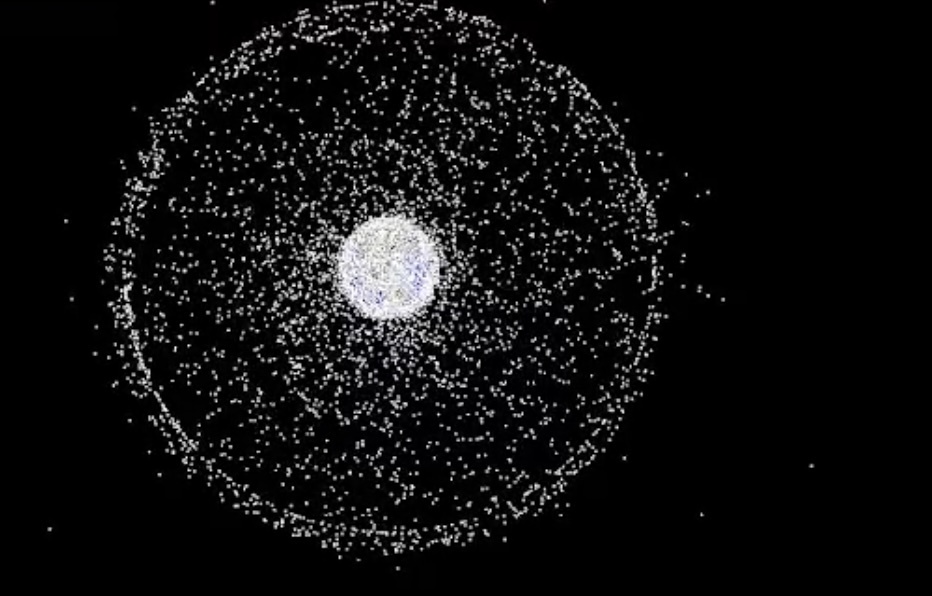3.05.2025
Out-of-control Soviet satellite Kosmos 482 to crash land on Earth in DAYS as scientist warns it could hit like a meteorite

3D map from Nasa shows extent of orbital debris and satellites circling our planet
The failed Venus lander will likely survive re-entry into Earth's orbit due to its specially designed heat shield
A half-tonne Soviet spacecraft is set to crash back to Earth next week, with experts predicting it could hit "like a meteorite" at around 150mph.
The Kosmos 482 probe, launched by the USSR in 1972 as part of a mission to Venus, has been circling our planet for 53 years.
Space tracker Dr Marco Langbroek has calculated that the defunct satellite will begin its descent around May 10, give or take a few days.
Much to the alarm of people on Earth, the spacecraft is likely to survive re-entry intact due to its heat shield, which was specially designed to weather Venus's harsh atmosphere.
Quelle: GB News
+++
A Soviet shuttle from the Space Race is about to fall uncontrollably from the sky
A ghost from time past is about to return to Earth. But it won't be smooth.

It’s not clear what the probe looks like because the Soviets kept it a secret. But it probably looks a bit like this museum replica. Image credits: NASA.
On March 31, 1972, Kosmos 482 blasted off from Kazakhstan, bound for Venus. It never got there.
Now, 53 years later, part of that failed mission — roughly the size of a small car and weighing half a ton — is on a final, uncontrolled descent to Earth.
It’s a half-tonne thing falling out of the sky at a couple of hundred miles an hour. That’s going to hurt (a lot) if it hits anyone.
A Venus lander, lost in orbit
Kosmos 482 was part of the Venera program, a series of Soviet probes that set the early benchmark for exploring Venus. Its twin, Venera 8, launched four days earlier and successfully transmitted 50 minutes of data from the planet’s searing surface.
Kosmos 482 wasn’t so lucky.
The capsule was meant to endure the fiery descent through Venus’s carbon-dioxide-rich atmosphere. But instead, after a rocket malfunction stranded it in Earth’s orbit, the lander has been circling the planet ever since. According to satellite observers, it’s expected to re-enter Earth’s atmosphere around May 10, give or take a few days.
There’s still no clear answer to where Kosmos 482 will land. With a 52-degree orbital inclination, it could come down anywhere between southern Canada and northern Argentina, encompassing most of Earth’s populated landmasses.
We don’t know where it’ll crash
The probe has a 52-degree orbital inclination. This means that the spacecraft’s orbit is tilted 52 degrees relative to Earth’s equator. With this type of orbital inclination, it could come down almost anywhere on the planet.
The biggest likelihood, however, is that it splashes into the ocean. As Dutch Marco Langbroek, a space situational awareness expert at Delft University of Technology, told The Guardian: “The biggest chances are that it will land in one of the oceans.” You shouldn’t lose any sleep over it, the researcher adds. “While not without risk, we should not be too worried.”
The odds of it striking a person remain minuscule. However, it will come down fast. Langbroek discovered the object’s impending re-entry and has been tracking it closely. He estimates it could hit at about 150 miles per hour (242 km/h).
What makes Kosmos 482 unusual — and potentially dangerous — is that it was built to endure. The capsule was designed to survive Venus, where temperatures soar above 460°C (860°F) and atmospheric pressure is over 90 times that of Earth. It may yet survive its plunge through our own atmosphere.
The parachute system, long dormant, almost certainly won’t deploy. After five decades in space, it’s unclear how the hardware has weathered time and cosmic radiation.
Our skies are full of junk
It’s not just the planet’s soil and oceans that we’re polluting.
There are over 14,000 satellites still in space. Many are intact and functioning; but others have crashed and broken into smaller pieces. According to some estimates, there are 170 million pieces of junk in Earth orbit. Sometimes, this junk makes its way back to Earth.
Space debris has been re-entering Earth’s atmosphere for decades. Most of it burns up harmlessly. But a growing number of large, uncontrolled objects — including defunct satellites and rocket stages — are starting to show up.
The Upper Atmosphere Research Satellite, which fell to Earth in 2011, weighed 5,900 kilograms — more than ten times the mass of Kosmos 482. China’s Long March rocket boosters have also made multiple uncontrolled re-entries, prompting international concern.
Kosmos 482 has an intriguing story. It’s a relic from the Cold War — launched in secrecy, never acknowledged as a failure by the Soviet Union. It was simply rebranded “Kosmos,” the USSR’s go-to label for spacecraft that failed to reach their intended orbits. For decades, it’s been more ghost than satellite. But now, it’s about to fall to Earth, like many other objects humanity has sent up.
It likely won’t cause any issues directly, but this is an illustration of a bigger issue. We’re going to have serious trouble cleaning up our space junk.
Quelle: ZME Science
----
Update: 10.05.2025
.
Seit mehr als 50 Jahren ist eine sowjetische Sonde nach gescheiterer Mission in der Erdumlaufbahn unterwegs gewesen. Einst sollte sie die Venus erreichen – nun stürzte sie ab.
Eine im Jahr 1972 von der Sowjetunion ins All geschossene Raumsonde ist nach russischen Angaben im Indischen Ozean abgestürzt. Der Raumapparat sei um 8.24 Uhr MESZ in die Erdatmosphäre eingetreten und dann westlich der indonesischen Hauptstadt Jakarta ins Meer gestürzt, teilte die russische Raumfahrtbehörde Roskosmos in Moskau mit. Zu möglichen Schäden gab es keine Angaben.
Die Europäische Weltraumorganisation ESA geht ebenfalls davon aus, dass die Sonde namens "Kosmos-482" mittlerweile in die Erdatmosphäre eingetreten ist. Da sie anders als erwartet um 9.32 Uhr nicht erneut von Radarsystemen über Deutschland erfasst worden sei, sei es "am wahrscheinlichsten", dass der Eintritt bereits geschehen sei. Am frühen Morgen hatten die Systeme über Deutschland die Sonde noch erfasst.
Sonde seit mehr als 50 Jahren in der Erdumlaufbahn
"Der Apparat wurde im Frühjahr 1972 zur Erkundung der Venus gestartet, blieb aber wegen einer Fehlfunktion der Oberstufe in einer hohen elliptischen Umlaufbahn um die Erde und näherte sich allmählich dem Planeten", teilte Roskosmos mit. Der Eintritt der Sonde sei durch ein automatisiertes System zur Warnung über gefährliche Situationen im erdnahen Weltraum kontrolliert worden, teilte die Behörde weiter mit.
Der Absturz der knapp 500 Kilogramm schweren Sonde mit rund einem Meter Durchmesser war von den Weltraumbehörden für Samstag erwartet worden. Allerdings war völlig unklar, wo sie auf die Erde treffen sollte.
Experten hatten zuvor damit gerechnet, dass die aus extrem widerstandsfähigem Material gefertigte Sonde als Ganzes auf der Erde ankommen könnte, weil sie dafür ausgelegt war, den Eintritt in die Atmosphäre der Venus zu überstehen. Roskosmos schrieb nun jedoch: "'Kosmos-482' gibt es nicht mehr." In welchem Zustand die Überbleibsel der Sonde nun sind, blieb unklar.
Sowjetunion erkundete die Venus
Die Sowjetunion schickte zwischen 1961 und 1983 im Rahmen des Verena-Programms mehrere Raumsonden Richtung Venus, um den fremden Planeten zu erkunden. Mehrere dieser Sonden landeten auch auf der Venus und sendeten von dort Informationen.
Quelle: t-online.de
